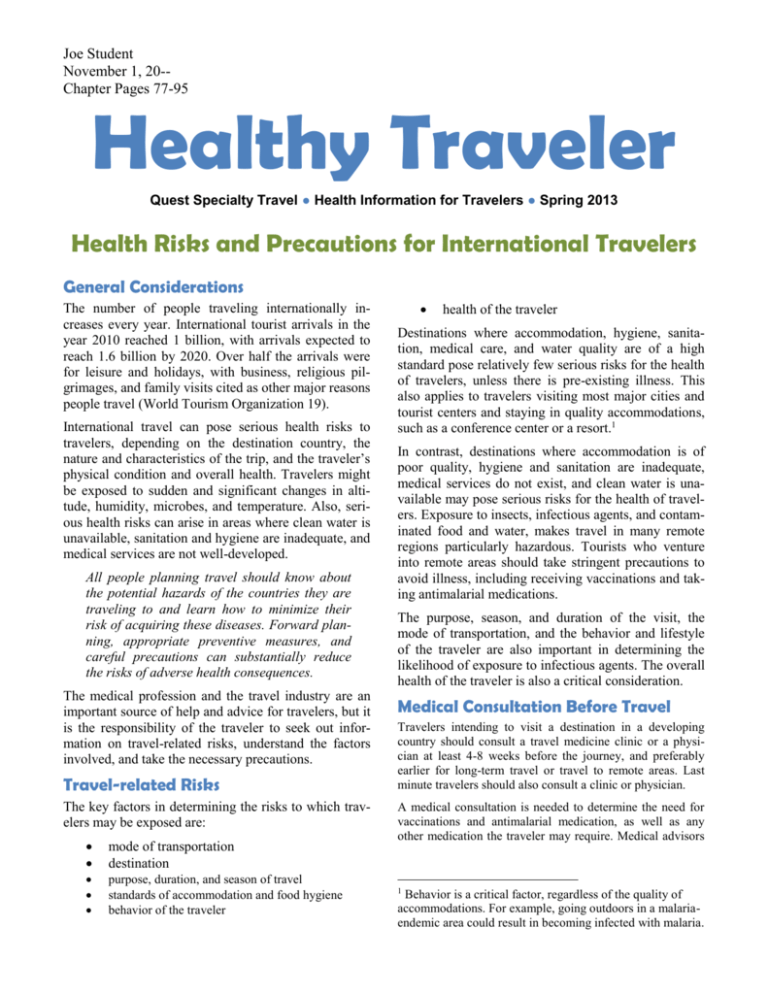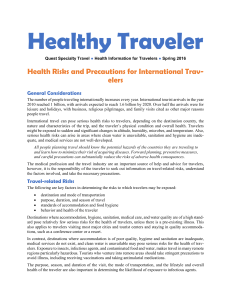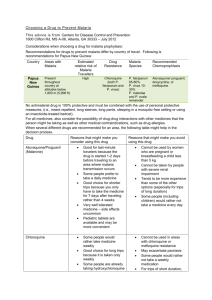Bibliography - Centerville Community Schools
advertisement

Joe Student November 1, 20-Chapter Pages 77-95 Healthy Traveler Quest Specialty Travel ● Health Information for Travelers ● Spring 2013 Health Risks and Precautions for International Travelers General Considerations The number of people traveling internationally increases every year. International tourist arrivals in the year 2010 reached 1 billion, with arrivals expected to reach 1.6 billion by 2020. Over half the arrivals were for leisure and holidays, with business, religious pilgrimages, and family visits cited as other major reasons people travel (World Tourism Organization 19). International travel can pose serious health risks to travelers, depending on the destination country, the nature and characteristics of the trip, and the traveler’s physical condition and overall health. Travelers might be exposed to sudden and significant changes in altitude, humidity, microbes, and temperature. Also, serious health risks can arise in areas where clean water is unavailable, sanitation and hygiene are inadequate, and medical services are not well-developed. All people planning travel should know about the potential hazards of the countries they are traveling to and learn how to minimize their risk of acquiring these diseases. Forward planning, appropriate preventive measures, and careful precautions can substantially reduce the risks of adverse health consequences. The medical profession and the travel industry are an important source of help and advice for travelers, but it is the responsibility of the traveler to seek out information on travel-related risks, understand the factors involved, and take the necessary precautions. Travel-related Risks The key factors in determining the risks to which travelers may be exposed are: mode of transportation destination purpose, duration, and season of travel standards of accommodation and food hygiene behavior of the traveler health of the traveler Destinations where accommodation, hygiene, sanitation, medical care, and water quality are of a high standard pose relatively few serious risks for the health of travelers, unless there is pre-existing illness. This also applies to travelers visiting most major cities and tourist centers and staying in quality accommodations, such as a conference center or a resort.1 In contrast, destinations where accommodation is of poor quality, hygiene and sanitation are inadequate, medical services do not exist, and clean water is unavailable may pose serious risks for the health of travelers. Exposure to insects, infectious agents, and contaminated food and water, makes travel in many remote regions particularly hazardous. Tourists who venture into remote areas should take stringent precautions to avoid illness, including receiving vaccinations and taking antimalarial medications. The purpose, season, and duration of the visit, the mode of transportation, and the behavior and lifestyle of the traveler are also important in determining the likelihood of exposure to infectious agents. The overall health of the traveler is also a critical consideration. Medical Consultation Before Travel Travelers intending to visit a destination in a developing country should consult a travel medicine clinic or a physician at least 4-8 weeks before the journey, and preferably earlier for long-term travel or travel to remote areas. Last minute travelers should also consult a clinic or physician. A medical consultation is needed to determine the need for vaccinations and antimalarial medication, as well as any other medication the traveler may require. Medical advisors 1 Behavior is a critical factor, regardless of the quality of accommodations. For example, going outdoors in a malariaendemic area could result in becoming infected with malaria. Joe Student November 1, 20-Chapter Pages 77-95 Healthy Traveler: Travel and Health Information from Quest Specialty Travel base their recommendations on an assessment of risk for the individual traveler as well as any associated public health. exists throughout the tropics, but it is most prevalent in subSaharan Africa. Malaria hotspots change constantly, so check with a travel medicine specialist or the Centers for Disease Control for the latest developments before you travel. Malaria: A Serious Health Risk for Travelers Second, take measures to prevent mosquito bites, particularly between dusk and dawn. Always sleep in a well-screened room, preferably under a mosquito net that has been treated with insecticide. During the evening, wear long pants and long-sleeved shirts, and apply an insect repellent that contains DEET. Each year an estimated 8 million North Americans travel to countries where malaria is common. Transmitted by the bite of an infected mosquito, malaria is a serious and potentially fatal infectious disease that is characterized by headaches, fever, chills, and sweating. Malaria occurs mostly in poor tropical and subtropical areas of the world. In many of the countries affected by malaria, it is a leading cause of illness and death. In areas with high transmission, the most vulnerable groups are young children, who have not developed immunity to malaria yet, and pregnant women, whose immunity has been decreased by pregnancy. (Centers for Disease Control and Prevention) Finally, consult your physician or a travel medicine specialist several weeks prior to departure for advice on taking antimalarial drugs. Prophylaxis drugs need to be taken continuously, beginning before travel commences and continuing through up to four weeks after leaving malaria-endemic areas. Even if you take antimalarial pills, it is still possible to get malaria, so seek medical treatment promptly if you experience flu-like symptoms and are in or have recently visited an area where malaria is present. For more information on malaria prevention and other travel health issues, check out the Centers for Disease Control on the Internet at www.cdc.gov/travel. According to the Centers for Disease Control, malaria can usually be prevented if travelers to tropical and subtropical regions follow these preventive steps: First, inform yourself about the risk of acquiring malaria in the region of the world where you plan to travel. Malaria Malaria Worldwide 3.3 billion people (half the world’s population) live in areas at risk for malaria transmission. 35 countries (30 in sub-Saharan Africa and 5 in Asia) account for 98% of global malaria deaths. The World Health Organization estimates that in 2010, malaria caused 350-500 million clinical episodes of malaria. An estimated 863,000 malaria deaths occur every year, most of them children. 89% of malaria deaths occur in Africa. Malaria is the fifth cause of death from infectious diseases worldwide (after respiratory infections, HIV/AIDS, diarrheal diseases, and tuberculosis). Malaria is the second leading cause of death from infectious diseases in Africa, after HIV/AIDS. Source: (Centers for Disease Control and Prevention) 2 Joe Student November 1, 20-Chapter Pages 77-95 Healthy Traveler: Travel and Health Information from Quest Specialty Travel Preventive Options for Serious Travel Health Issues Disease Vaccine Malaria Typhoid Hepatitis A Cholera Japanese Encephalitis Prophylaxis Drug Eat and Drink Safely +Medical Kit and Personal Items Travelers should always carry a medical kit, particularly to destinations where there may be significant health risks, including developing countries where local availability of medications cannot be guaranteed. The medical kit should include basic medicines to treat common ailments, first aid items, and any other special items, such as syringes and needles, that might be needed for a pre-existing medical condition. It is also important to bring a signed statement from a physician certifying that the traveler requires specific medication or items for a medical condition. Travelers should also carry personal items in sufficient quantity for the length of the visit, unless their availability is assured at the travel destination. Such items might include toothpaste, supplies and solutions for contact lenses, skin care items, and other items for personal hygiene. Antiseptic wound cleanser Cotton swabs Digital thermometer Disposable gloves Elastic bandage wrap for sprains and strains First aid quick reference card Insect repellent Medication for pain or fever, such as Acetaminophen, Aspirin, or Ibuprofen Moleskin for blisters Oral rehydration salts Saline eye drops Scissors, safety pins, and tweezers2 Sterile dressing The Centers for Disease Control and Prevention recommends travelers carry the following items for a basic medical kit: First aid items Avoid Insects Adhesive bandages, multiple sizes Adhesive tape Antibacterial hand wipes or an alcohol-based hand sanitizer containing at least 60% alcohol Antifungal and antibacterial ointments Antihistamine Anti-itch cream for insect bites and stings 2 3 Pack these items in checked luggage. Joe Student November 1, 20-Chapter Pages 77-95 Healthy Traveler: Travel and Health Information from Quest Specialty Travel Other important items The following items might be necessary depending on the destination, trip duration, and individual needs: Antibiotic for self-treatment of diarrhea Antidiarrheal medication Antifungal powder Antimalarial medication Anti-motion sickness medication Epinephrine auto-injector (such as an EpiPen) for severe allergic reactions Extra pair of contacts or prescription glasses Medication for high-altitude sickness Medications taken on a regular basis at home3 Mild laxative Mild sleep aid or anti-anxiety medication Sterile syringes and needles Sunscreen4 Water purification tablets Contact card Travelers should carry the name and contact details for their physician, together with information about any medical conditions, treatments, and medications, including generic drug names and doses. The contact card should also include contact information for a family member still in the traveler’s home country and the home embassy or consulate in the destination country. 3 All medications should be stored in carry-on luggage, in their original containers with clear labels. Carry a duplicate supply in checked luggage. 4 SPF 15 or greater. 4 Joe Student November 1, 20-Chapter Pages 77-95 Healthy Traveler: Travel and Health Information from Quest Specialty Travel Determine malaria risk and plan for prevention of mosquito bites, antimalarial drugs, mosquito net, and insect repellent Insurance for Travelers International travelers should be aware that medical care abroad is often only available at private medical facilities, and can be extremely expensive. In places where highquality medical care is not readily available, travelers might need to be repatriated in the event of an accident or illness. Repatriation of the body can be costly and difficult to arrange if death occurs abroad. Establish a plan for food hygiene Eat only thoroughly cooked food and drink only bottled water or packaged drinks Boil, filter, or disinfect water if bottled water will not be available Assemble a suitable medical kit Include items for basic first aid and items specific to the destination and the traveler’s personal needs Obtain prescription medications Travelers are advised to seek information about possible reciprocal health-care agreements between the country of residence and the destination country, and to obtain special traveler’s health insurance for destinations where health risks are significant and medical care is expensive and not readily available. Subscribe to travel medical insurance Look for insurance that covers changes in itinerary, medical care, hospitalization, as well as repatriation. Travel health insurance should include coverage for changes to the itinerary, emergency repatriation for health reasons, medical care in case of illness or accident, hospitalization, and repatriation of the body in case of death. Bibliography Some countries now require proof of adequate health insurance as a condition of entry. Travelers should be familiar with the procedures to obtain medical assistance if needed while abroad, and should carry a copy of the insurance certificate, along with other important travel documents, in their carry-on luggage. n.d. Boswell, Catherine. International Tourism: American Tourism Organization Web site. 9 September 2012. 11 March 2013 <www.amtourism.org>. Centers for Disease Control and Prevention. "Malaria." 10 February 2013. Centers for Disease Control and Prevention Web site. 11 March 2013 <http://www.cdc.gov/malaria>. Clinton, Edmund. "Malaria in Children." Journal of Tropical Medicine (2011): 89-94. Johnson, Margaret. "Advice for International Travelers." The Journal of Travel Medicine (2012): 45-87. Matthews, Philip, ed. Principles and Practices of Travel Medicine. New York: World Press, 2009. World Health Organization. "International Travel and Health 2013 Edition." 10 January 2013. World Health Organization. 11 March 2013 <http://www.who.int/ith/>. World Tourism Organization. Tourism Highlights. White Paper. Madrid: World Tourism Organization, 2012. Traveler’s Checklist When preparing for an international trip, travelers can use the following checklist as a guide: Determine local conditions Risks related to the destination (urban, rural, or remote) Type of accommodation (resort, local hotel, or camping) Length of stay Altitude Regional conflicts Standards of hygiene and sanitation Availability and quality of medical facilities Arrange a medical consultation Visit a physician or travel clinic 4-8 weeks prior to departure Receive required and recommended vaccinations Joe Student 5






